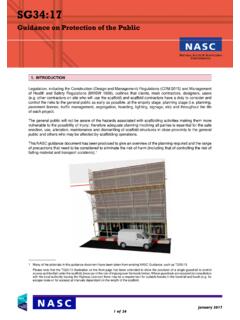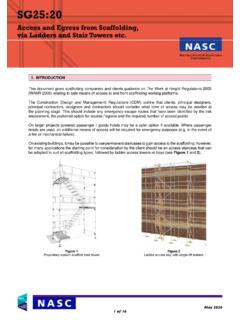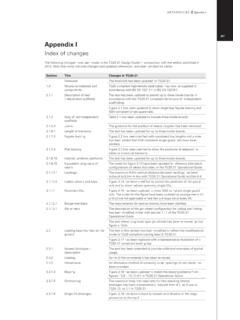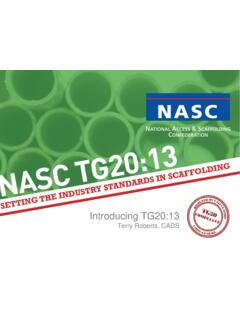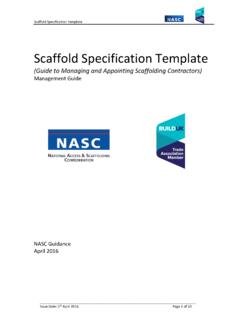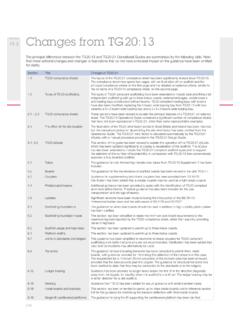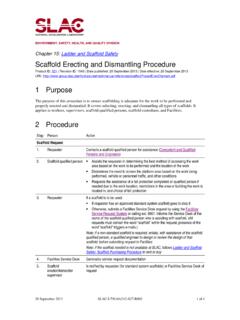Transcription of Preventing Falls in Scaffolding Operations
1 IJuly 2016SG4:15 Preventing Falls in Scaffolding OperationsiiNATIONAL ACCESS & Scaffolding CONFEDERATIONiPreventing Falls inScaffolding OperationsNational Access and Scaffolding Confederation4th Floor, 12 Bridewell Place, London EC4V 020 7822 7400 Fax: 020 7822 7401 Safety Guidance 4: 2015iiPublished by:National Access & Scaffolding Confederation (NASC)4th Floor, 12 Bridewell PlaceLondon EC4V 6 APTel: 020 7822 7400 Fax: 020 78227401 Email: NASC 2015 First published 2015 ISBN 978-0-9934076-0-4 Designed and illustrated by Steve PhillipsPrinted by Lithoflow Limited, LondonAll rights reserved. No part of this publication may be reproduced, stored in a retrieval system, or transmitted in any form or by any means, electronic, mechanical, photocopying, recording or otherwise, without the prior permission of the publisher and copyright preparation of this NASC Guide to Preventing Falls in Scaffolding was entrusted to The NASC SG4 Working Party by the Council of the National Access and Scaffolding AuthorSimon Hughes CMIOSH, MIIRSMS imian Risk Management LimitedThis guide takes the form of recommendations and guidance.
2 It should not be quoted as if it were a specification. It does not purport to include all the necessary provisions for a contract and users are responsible for their guide has been written on the assumption that the execution of its provisions is entrusted to appropriately qualified and experienced people and that construction and supervision of scaffolds will be carried out by capable and experienced and Simian Risk Management Limited shall be under no liability of whatsoever kind however caused whether or not due to the negligence or wilful default of NASC or their servants or agents arising out of or in connection with this document or any part issued since
3 PublicationAmd. No. 1 Date 1 July 2016 CommentsFront cover - Addition of HSE logo. Front cover - Date changed to July vii - Incorporation of a Foreword from HSEPage viii - Replacement of Preface by Kevin Ward with Preface by Alan Lilley, NASC ACCESS & Scaffolding CONFEDERATIONiiiContents Contents iii Figures v Foreword vii Preface viii01 Introduction 102 Planning for work at height Competence and capability Training and instruction Supervision Site inspection and risk assessment 8 Rescue planning Collective fall protection (3rd Party) Weather conditions Temporary works design Scaffolding operatives responsibilities 1003 The scaffolders safe zone Working platforms Methods of constructing a scaffolders safe zone Scaffolders step Push up advanced guardrail tool 18 Proprietary advanced guardrail systems (AGS) Protected traversing Short-lift system Tube and fitting frame type AGS Tube and fitting horizontal type AGS 2404 Other Scaffolding applications Scaffolding from a mobile elevating work platform (MEWP) Proprietary system Scaffolding Shorter lifts (Bricklayers lifts)
4 Tall lifts (floor height lifts, pavement lifts and gantries) Birdcage access Scaffolding Bridging with beams 29 Loading bays 30 Protection fans and cantilevered systems 30 Chimney stacks Scaffolding (roof saddles) Temporary roofs Hoist towers and debris chutes Temporary edge protection Falsework, formwork and other temporary structures 3605 Methods of access and egress 3706 Personal fall protection equipment Fall arrest harnesses and lanyards Single fall arrest lanyards Double fall arrest lanyards Anchor points, connectors and anchor devices Anchor points Suitable scaffold anchor points Unsuitable scaffold anchor points Anchoring to standards Anchorages to proprietary Scaffolding systems Guidelines for anchorages on other structures Anchorages to lightweight mobile access towers (MATs)
5 Inertia reels Hybrid self-retracting lanyards Horizontal line systems Inspection and maintenance of personal fall arrest euipment Personal fall arrsest equipment manufacturers instructions 4807 Rescue Assisted rescue without specialist rescue euippment Specialist rescue equipment Rescue training 51 08 Appendices 52 Relevant Health & Safety Law 52 British & European Standards 53 References and further reading 54 Acknowledgements 55 NATIONAL ACCESS & Scaffolding CONFEDERATIONvFigures 1 NASC Members Falls from Height 1999-2014 1 2 Guardrails attached to pre-cast concrete staircase sections 3 3 Pre-assembled guardrails fixed to structural steelwork ( I beams) 3 4 Scaffolder protected by a guardrail in the scaffolders safe zone 4 5 Work at Height Regulations 2005 Hierarchy of Controls 5 6 CISRS cards 6 7 Extract from a drawing showing hazard warning.
6 9 8 Inherent risk of a fall in Scaffolding 11 9 Shows a scaffolder exposed to a risk of falling 12 10 A temporary scaffolders working platform to form the minimum scaffolders safe zone 12 11 A finished working platform for users 12 12 A scaffolder reaching below the single guardrail must be clipped on 13 13 safe handling bay 13 14 Temporary working platform 13 15 Boarding out first lift from below 14 16 Examples of other collective fall arrest systems 15 17 Restricted access 15 18 Illustration shows a scaffolder hemping a standard over a guardrail 16 19 Examples of a scaffolders step used to install guardrails in advance 17 20 Scaffolder installing a guardrail in advance to the next lift from a scaffolders step 17 21 Shows the scaffolders step being used with at base lift 17 22 System scaffold side brackets used to create a scaffolders step 18 23 Push type Advanced Guardrail Tool (AGT) 18 24 Example of a system scaffold specific advanced guardrail tool.
7 18 25 A selection of proprietary advanced guardrail systems (AGS) 19 26 Shows the modified sequence of erection for a push-up AGS 20 27 An example of an integrated advanced guardrail system 20 28 Protected Traverse 21 29 Short-lift system 22 30 Tube and fitting AGS frame 23 31 AGS frame constructed on the ground and fixed to the base lift 23 32 Tube and fitting horizontal advanced guardrail sequence 24 33 Scaffolders using a MEWP to erect a suspended scaffold 25 34 Fall restraint lanyard and combination lanyard 25 35 An example of an anchor point for a proprietary Scaffolding system 26 36 Shorter lift heights 26 37 A sequence of work for floor height lifts 27 38 Tall Lifts 28 39
8 A podium scaffold used to erect a pavement lift 28 40 Example of a birdcage Scaffolding system of work 29 41 Example of bridging with beams 29 42 Example of a loading bay gate 30 43 Temporary guardrail for loading bay gate installation and removal 30pagevi 44 Falling object protection fan erected using an inertia reel 30 45 An example of a temporary guardrail assembly used to provide a 31 scaffolders safe zone during the erection of a truss-out cantilevered scaffold 46 Example of a roof saddle sequence of work with eaves edge protection and 32 continual attachment and eaves edge protection 47 Examples of proprietary temporary roof systems 33 48 An example of traditional temporary roof erected in-situ 33 49 Debris chute or hoist tower construction 34 50 Scaffolder erecting roof edge protection from a MEWP 34 51 Safety net fan system 34 52 Fall arrest netting rigged to a fragile roof light 35 53 Scaffolder utilising an installed fall protection system for roof access 35 54 Formwork system erected on the ground or slab and lifted into position to 36 avoid the need to work at height 55 Fully decked and guardrailed working platform for a formwork system 36 56 A Scaffolder raising platform boards to the next lift 37 57 Typical proprietary
9 System scaffold stairway 37 58 Ladder access bays with single-lift ladders 37 59 Internal ladder access with a protected ladder trap 38 60 External ladder access using a safety gate 38 61 A standalone loading tower with access built in 38 62 A minimum suggested personal fall arrest system 39 63 High specification harness and lanyard systems 40 64 Fall factors 40 65 Minimum fall distance - Shows a hybrid self-retracting fall arrest lanyard 40 66 The maximum length of fixed length lanyard 41 67 Twin-tail lanyard that shares a common energy absorber 41 68 Double lanyard system using two separate fall arrest lanyards 41 69 Scaffolder using a twin-tailed energy absorbing lanyard 42 70 An example of a sacrificial lanyard parking point 42 71 Typical options for stowing and securing a lanyard when not in use 42 72 Examples of suitable anchor points 43 73 Examples of unsuitable anchor points 44 74 Anchor devices 44 75 A selection of special connectors and anchor devices 45 76 The pendulum effect 46 77 A slung scaffold being erected by a scaffolder 46 78 Examples of a hybrid self retracting lanyard system 47 79 A proprietary line system 47 80 Retrievable type inertia reel 49 81 Recovery from height by emergency services 49 82 Examples of remote
10 Rescue equipment for Scaffolding applications 50 83 Fully assisted rescue situation 51pageSECTION03 NATIONAL ACCESS & Scaffolding CONFEDERATIONviiForewordFalls from height continue to be the largest single cause of fatal and life changing injuries for workers across industry. Scaffolders, when erecting, altering or dismantling Scaffolding are regularly exposed to the risk of a fall. This guidance clearly shows that with proper planning, preparation, provision and use of the correct equipment and systems of work, the risk of a fall can be eliminated or is encouraging that the NASC continues to fulfil their commitment as a tradeorganisation t
